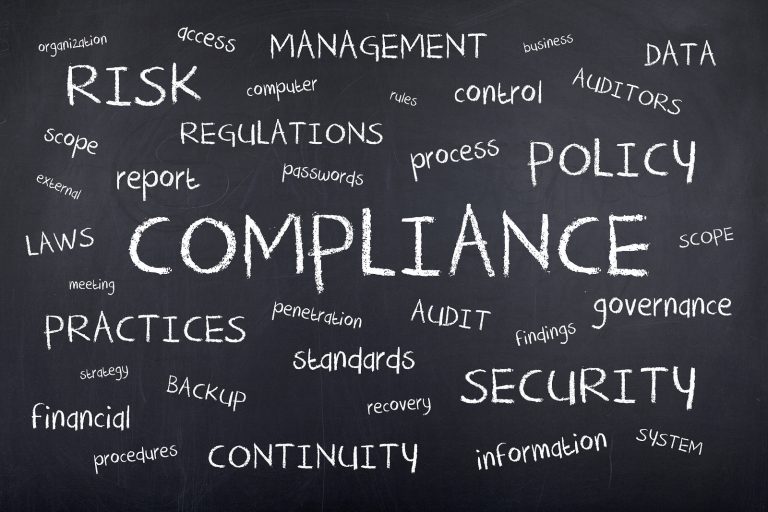With the ever-increasing risk of data breaches, governments and industry bodies are coming up with regulations to protect consumers. These regulations are meant to compel businesses to adopt a security-first approach in the transmission, storage, and access of sensitive data. As a result, data security compliance has become imperative in running businesses rather than just one of the many best practices.
The compliance manager is in charge of the company’s compliance program. This professional should keep abreast of changing compliance laws and ensure the company has the appropriate controls in place to keep data safe and avoid regulatory penalties or fines.
However, the compliance process should be a team effort and not a one-person responsibility. The compliance manager should work together with internal stakeholders, including the Board and C-Suite to come up with appropriate program oversight and review compliance efforts. Departmental heads should also be included in compliance policy making and employees encouraged to follow the policies.
Creating a Risk Management Program to Enhance Compliance

Successful compliance relies on robust risk management initiatives by the company. It is important for organizations to identify, assess, analyze, and determine their risk tolerance to protect themselves from fines, penalties, and even employee jail times.
Any apparent data risks in the company should be countered by standby mitigation strategies such as internal controls.
To create a successful risk management program, it is important to have written policies and guidelines on the organization’s operations. The policies and guidelines should provide internal protocols for accessing data and mitigation steps to be initiated in case of breaches.
Risk control policies should guide the overall compliance program of the organization. Moreover, the policies should be followed by all engaged stakeholders to reduce the risk of compliance gaps in internal processes or by employees.
Auditing Your Compliance Program
Setting up a robust compliance program is not enough; there has to be a way of monitoring the program.
This is where auditing comes in.
Government and industry regulations require companies to audit their compliance processes on a regular basis to ensure the integrity of their systems. Internal and external audit processes should be carried out as required. Moreover, the company’s compliance policies should outline the audit requirements and document the exact procedures to be followed to ascertain compliance.
Monitoring Your Compliance Program
Cybersecurity threats are always evolving and companies need to consistently monitor their data environments to ensure their integrity. Apart from monitoring, mitigation measure should be in place, ready to be activated when required. Finally, organizations should document their monitoring and response processes for auditing purposes. Any compliance actions carried out should be documented to ease the auditing process.
Strengthening Your Data Environment through an Effective Compliance Program
Internal corporate compliance policies typical establish the guidelines for maintaining data with confidence and integrity. However, the policies cannot be used as the primary basis for a cybersecurity program.
When you want to attain compliance, you are likely to have to deal with multiple regulatory requirements from both government and industry bodies. Some of the regulations are entangled in bureaucratic processes and may be out of date in the rapidly changing data risk environment your business may be operating in.
Therefore, your overall compliance program should be built around securing access to sensitive data based on the latest security protocols and recommended guidelines.
Building a Security-First Compliance Program
To ease compliance and security burdens, companies should take a security-first approach with regards to any infrastructure and data in their environments. Stringent regulations means that firms have to play an active role in not only restricting access to data but also protecting it.
Below is an overview of how you can ensure your company maintains compliance:
i) Continuously mitigate risk
Internal compliance policies may provide the steps and procedures for mitigating data breaches. However, following protocols may not entirely keep your data safe. This is why risk mitigation involves more than just ticking checklists and boxes.
It is important to have a continuous risk mitigation process that involves regular audits and tests to ensure the security of your data environment.
ii) Compliance training should be an ongoing process
Your staff should undergo regular compliance training to internalize the best practices of accessing and handling sensitive data. Various forms of training, including theory and practical education, should be provided to ensure employees understand risk theory and mitigation measures.
Compliance training should be provided to the whole company, including C-suite employees as well as the Board of Directors.
iii) Create Standards of Conduct
Data breaches can occur both due to external attacks or employee security flaws. Therefore, there should be a code of conduct with regards to password security, using company devices on public Wi-Fi, using personal devices at the company, and so on.
IT should come up with security requirements to ensure employees are using strong passwords. Devices and other technology infrastructure should be configured to prevent input of weak passwords and protocols established to limit employee access to sensitive data.
iv) Maintain discipline
Maintaining compliance discipline is also important to ensuring the organization does not suffer data breaches. The C-suite should take the lead in following and implementing a security code of conduct in the organization. Regular reviews should be carried out and refresher trainings provided to ensure all employees understand compliance requirements and are following them to the latter.
Author Bio
 Ken Lynch is an enterprise software startup veteran, who has always been fascinated about what drives workers to work and how to make work more engaging. Ken founded Reciprocity to pursue just that. He has propelled Reciprocity’s success with this mission-based goal of engaging employees with the governance, risk, and compliance goals of their company in order to create more socially minded corporate citizens. Ken earned his BS in Computer Science and Electrical Engineering from MIT. You can learn more at ReciprocityLabs.com.
Ken Lynch is an enterprise software startup veteran, who has always been fascinated about what drives workers to work and how to make work more engaging. Ken founded Reciprocity to pursue just that. He has propelled Reciprocity’s success with this mission-based goal of engaging employees with the governance, risk, and compliance goals of their company in order to create more socially minded corporate citizens. Ken earned his BS in Computer Science and Electrical Engineering from MIT. You can learn more at ReciprocityLabs.com.
0 Comment(s)